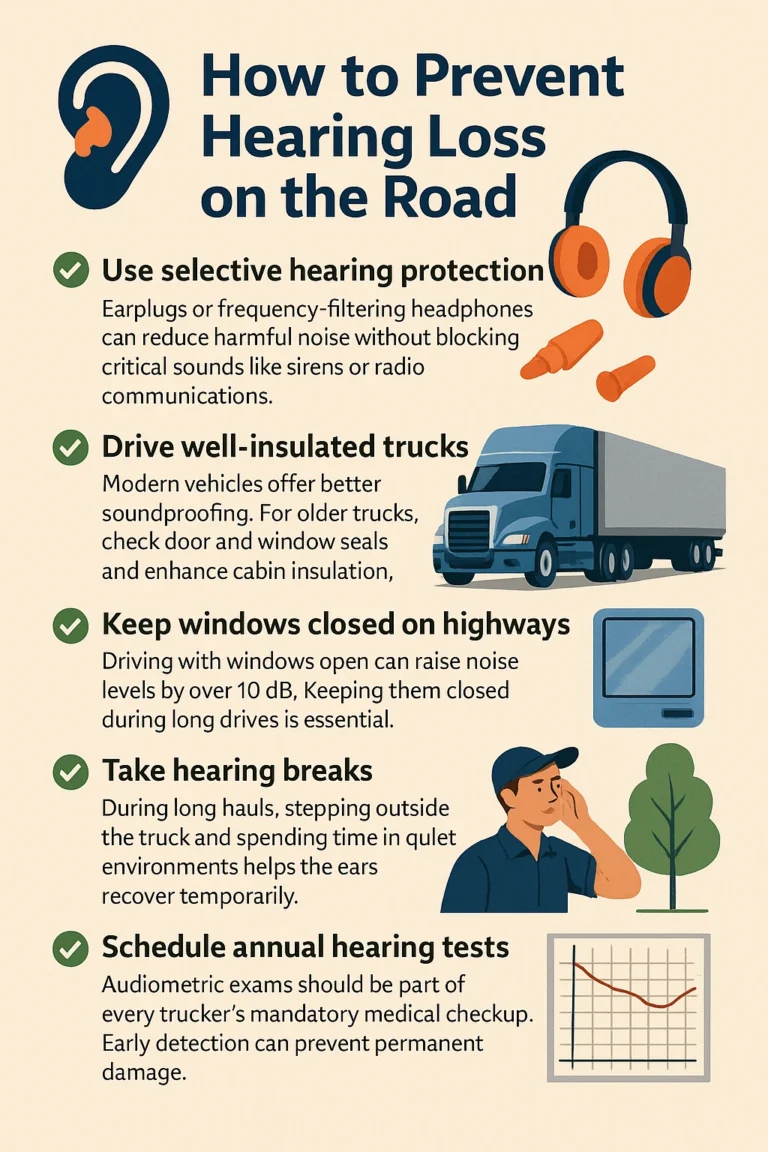Recent studies from the United States, India, and other countries point to an alarming diagnosis—truck drivers are increasingly exposed to noise levels that exceed safe thresholds, causing irreversible damage to their hearing.
As road safety campaigns multiply, few are addressing a nearly invisible threat affecting thousands of drivers worldwide: progressive hearing loss. Recent studies from the United States, India, and other countries point to an alarming diagnosis—truck drivers are increasingly exposed to noise levels that exceed safe thresholds, causing irreversible damage to their hearing.

A Slow but Steady Decline
According to a report from the U.S. Federal Motor Carrier Safety Administration (FMCSA), over 26% of heavy truck drivers in the U.S. already show signs of hearing loss—a rate higher than that of other industrial sectors. Most of these cases are linked to prolonged exposure to truck engine noise, road-tire friction, and wind entering through open windows.
The problem worsens over time. Noise-induced hearing loss doesn’t happen overnight—it’s a cumulative form of damage that can go unnoticed for years until it begins to interfere with basic tasks like hearing an alarm, detecting emergency sirens, or simply communicating over the radio.
A study by the University of Chennai in India revealed that over 70% of the truckers analyzed showed moderate to severe hearing loss in at least one ear. In North America, some cases show asymmetric hearing loss—worse in the ear most exposed to traffic or wind, especially when driving for hours with the window open.

What Causes It?
Common factors contributing to hearing damage among truck drivers include:
Prolonged exposure to engine and road noise (above 85 dB).
Poor acoustic insulation in older or poorly sealed cabs.
Chronic use of air horns and air brakes.
Long work shifts without adequate hearing recovery breaks.
Driving with windows open for extended periods, which amplifies wind noise on one side.
How to Prevent Hearing Loss on the Road
Occupational health experts and audiologists recommend several strategies to protect truckers’ hearing:
✅ 1. Use selective hearing protection
Earplugs or frequency-filtering headphones can reduce harmful noise without blocking critical sounds like sirens or radio communications.
✅ 2. Drive well-insulated trucks
Modern vehicles offer better soundproofing. For older trucks, check door and window seals and enhance cabin insulation.
✅ 3. Keep windows closed on highways
Driving with windows open can raise noise levels by over 10 dB. Keeping them closed during long drives is essential.
✅ 4. Take hearing breaks
During long hauls, stepping outside the truck and spending time in quiet environments helps the ears recover temporarily.
✅ 5. Schedule annual hearing tests
Audiometric exams should be part of every trucker’s mandatory medical checkup. Early detection can prevent permanent damage.
A Wake-Up Call for the Industry
Despite technological progress in the transport sector, hearing protection remains an unresolved issue in logistics. Incorporating hearing health policies in fleets, providing protective equipment, and educating drivers can make a significant difference. As silent as it may be, hearing loss deserves a louder conversation.

Mobile Clinics: The Unsung Heroes Bringing Healthcare to America’s Highways
The drivers of these massive trailers have become the unsung heroes of America’s roads, delivering life-saving medical services to every corner of the country.

Ending CDL reciprocity: the U.S. seeks stricter measures
New bill would require states to comply with the strict CDL regulations recently established. The U.S. House of Representatives has introduced new legislation aimed at

Cargo theft costs the transportation industry $18 million in losses
Cargo theft has been one of the most persistent issues facing the freight transportation industry so far in 2025. Cargo theft has been one of

Duffy Secures $41 Million to Save Essential Air Service as Shutdown Threat Looms
U.S. Transportation Secretary Sean P. Duffy announced on Wednesday that the Department of Transportation (DOT) has secured $41 million in additional emergency funding to sustain the Essential Air Service (EAS) program, a federal initiative that subsidizes commercial flights to rural and underserved communities across the United States.

Expanding opportunities for young drivers: the DRIVE Safe Act
The House of Representatives has reintroduced a proposal aimed at facilitating access for young drivers under the age of 21 to operate trucks across state

25% tariffs on medium and heavy trucks postponed
The 25% tariffs on medium and heavy trucks have been rescheduled, set for November 1. The 25% tariffs on medium and heavy trucks have been
